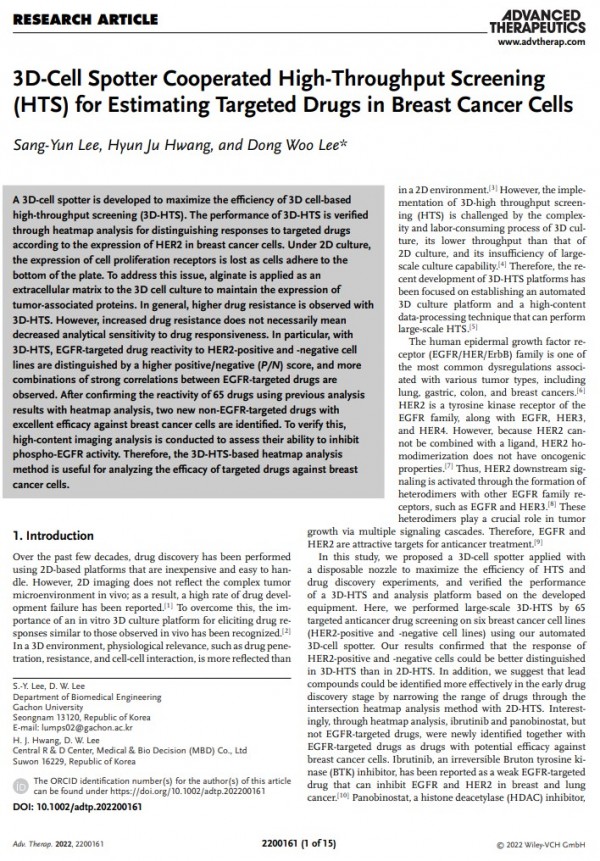논문 2022, Advanced Therapeutics, 3D-Cell Spotter Cooperated High-Throughp…
페이지 정보

본문
Abstract
A 3D-cell spotter is developed to maximize the efficiency of 3D cell-based high-throughput screening (3D-HTS). The performance of 3D-HTS is verified through heatmap analysis for distinguishing responses to targeted drugs according to the expression of HER2 in breast cancer cells. Under 2D culture, the expression of cell proliferation receptors is lost as cells adhere to the bottom of the plate. To address this issue, alginate is applied as an extracellular matrix to the 3D cell culture to maintain the expression of tumor-associated proteins. In general, higher drug resistance is observed with 3D-HTS. However, increased drug resistance does not necessarily mean decreased analytical sensitivity to drug responsiveness. In particular, with 3D-HTS, EGFR-targeted drug reactivity to HER2-positive and -negative cell lines are distinguished by a higher positive/negative (P/N) score, and more combinations of strong correlations between EGFR-targeted drugs are observed. After confirming the reactivity of 65 drugs using previous analysis results with heatmap analysis, two new non-EGFR-targeted drugs with excellent efficacy against breast cancer cells are identified. To verify this, high-content imaging analysis is conducted to assess their ability to inhibit phospho-EGFR activity. Therefore, the 3D-HTS-based heatmap analysis method is useful for analyzing the efficacy of targeted drugs against breast cancer cells.
A 3D-cell spotter is developed to maximize the efficiency of 3D cell-based high-throughput screening (3D-HTS). The performance of 3D-HTS is verified through heatmap analysis for distinguishing responses to targeted drugs according to the expression of HER2 in breast cancer cells. Under 2D culture, the expression of cell proliferation receptors is lost as cells adhere to the bottom of the plate. To address this issue, alginate is applied as an extracellular matrix to the 3D cell culture to maintain the expression of tumor-associated proteins. In general, higher drug resistance is observed with 3D-HTS. However, increased drug resistance does not necessarily mean decreased analytical sensitivity to drug responsiveness. In particular, with 3D-HTS, EGFR-targeted drug reactivity to HER2-positive and -negative cell lines are distinguished by a higher positive/negative (P/N) score, and more combinations of strong correlations between EGFR-targeted drugs are observed. After confirming the reactivity of 65 drugs using previous analysis results with heatmap analysis, two new non-EGFR-targeted drugs with excellent efficacy against breast cancer cells are identified. To verify this, high-content imaging analysis is conducted to assess their ability to inhibit phospho-EGFR activity. Therefore, the 3D-HTS-based heatmap analysis method is useful for analyzing the efficacy of targeted drugs against breast cancer cells.

 2023, International Journal of Molecular Sciences, An Automated High-Throughput Screening (HTS) Spotter for 3D Tumor Spheroid Formation
2023, International Journal of Molecular Sciences, An Automated High-Throughput Screening (HTS) Spotter for 3D Tumor Spheroid Formation 2022, scientific reports, Optimization of 3D‑aggregated spheroid model (3D‑ASM) for selecting high efcacy drugs
2022, scientific reports, Optimization of 3D‑aggregated spheroid model (3D‑ASM) for selecting high efcacy drugs